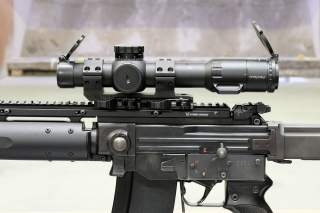Meet Sturmgewehr 57: Sig Sauer's Very First 'Battle' Rifle
We take a look.
While Sig Sauer, Inc. may have entered the battle rifle market recently, the original company—SIG, Schweizer Industrie Gesellschaft—produced a variety of them. SIG’s most famous was the SIG SG 510, otherwise known as the Sturmgewehr 57.
Though the Sturmgewehr 57 was a very early battle rifle that retained many vestiges of Swiss bolt action rifles before it, it also featured many thoughtful features and is considered to be among the best battle rifles in the world.
More than anything else, the Sturmgewehr 57 was built for accuracy. The standard Sturmgewehr 57 features a 23-inch long barrel, 3 inches longer than an M16. While this makes it rather unwieldy for close quarters combat or for mechanized troops that might need to enter and exit a vehicle, it suits the light infantry role most Swiss units were set up for at the time. The rifle also featured an integrated bipod, rifle grenade launcher, and excellent diopter sights.
Unlike most rifles where sight adjustment increments remain the same across the range of adjustment, the Sturmgewehr 57 features finer range adjustment increments at extended ranges, where precise ranging matters far more because a fired bullet drops more rapidly the further it goes. Of course, the Sturmgewehr 57’s sights are still reliant on the soldiers knowing precise ranges to targets, but in the Swiss case, most infantry would likely be defending from positions with existing range tables, which would allow them to dial in their sights with great accuracy.
On the other hand, these features come at the cost of great weight. At 12 lbs, the Sturmgewehr 57 is heavier than most WWII firearms. While this weight makes recoil very manageable (by some accounts, only one-third of the K31 bolt action rifle that preceded it), it means the rifle was almost definitely a pain to carry.
The sum of its features makes the Sturmgewehr 57 a kind of paradoxical rifle. It featured many modern features like a totally inline stock and barrel configuration with ironsights mounted significantly higher than the barrel at eye level (similar to the setup on the FG42, and later M16). It also was made of steel stampings, in contrast to the earlier K31 rifle that relied on time-consuming machining.
On the other hand, it featured many throwbacks to older rifles such as the “beer keg” charging handle that directly resembled that of the earlier Swiss rifles and the usage of the full power 7.5 Swiss round, instead of moving to a less powerful caliber like the United States did with 7.62x51 or the Soviets with the 7.62x39.
However, when one considers the specific requirements the Swiss army asked for, the rifle was very much purpose built to the kind of fight it was expected to partake in. The Swiss took what they liked from the past and combined it with the latest advances in manufacturing technology and rifle design.
The result is perhaps the most powerful and accurate battle rifles to ever see service. While the Sturmgewehr 57 is not the best choice for most nations that planned to fight maneuver wars or counterinsurgency wars due to its heavy weight, from a pure shooting perspective, the rifle is probably the best in the world. Meanwhile, the civilian version of the rifle remains popular for shooting competitions in Switzerland to this day.
Charlie Gao studied political and computer science at Grinnell College and is a frequent commentator on defense and national security issues.
Image: Sig Sauer

